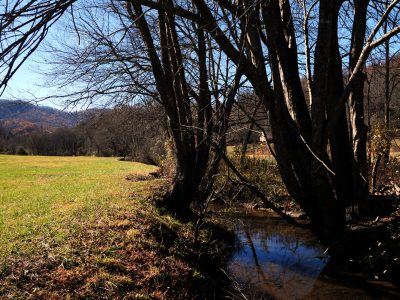
Scaling Up to the Catchment
Scaling Up to the Catchment
Though Coweeta became one of the first LTER sites in 1980, the Coweeta Hydrologic Laboratory as funded by the United States Forest Service has been in existence since 1934. Today the LTER and the Coweeta Hydrologic Laboratory coexist in the same complex of buildings and laboratories, collaborating and sharing data that now spans nearly eight decades. This data set has given Coweeta researchers unprecedented access to information about forest effects of both natural disturbances and human management.
In the 1930s, researchers selected several basins to study the effects of human management on forest hydrology. Researchers designated different watersheds to receive different treatments, such as clear cutting, clear cutting and replanting with pine, or conversion to agriculture, and continued to record data for many decades after treatment. Long-term study of this data has documented how the disturbance agent, gap size, and species-specific demography affect both recovery of the forest and hydrology in the long and short term. For example, researchers have found that on watersheds where hardwood vegetation was clearcut and watersheds converted from hardwoods to pine or hardwoods to grass that mean stream nitrate concentrations far exceeded measurements from control sites even 18-39 years after treatment.
Since these early experiments, the valley has continued to experience both natural and anthropogenic disturbance. The effects of disease, invasions of non natives, hurricanes, and droughts as well as different types of logging, agriculture, and increasing rates of exurban development have all been captured by the long-term vegetation plots first established in the 1930s. All of these have been effectively recorded in data that researchers can now analyze, with the help of models, to scale the effects of disturbance across temporal and spatial scales that remain invisible without the ability to incorporate such broad ranging data. New natural disturbances continue to occur on land monitored by Coweeta. The recent appearance of the Hemlock Wooly Adelgid in Macon County has been closely monitored by Coweeta scientists, and the combination of existing long-term plots and intensive short-term measurements will undoubtedly prove invaluable in anticipating and responding to the ecological impacts of this latest disturbance. Comprehensive climatic, hydrologic, and biogeochemical databases, made possible by the long-term nature of LTER funding and long-term measurements of vegetation dynamics, provide a template for understanding broader and more complex environmental issues. These environmental issues incorporate climate change, carbon cycling, and atmospheric deposition as they relate to effects on water resources and the productivity and health of forests.
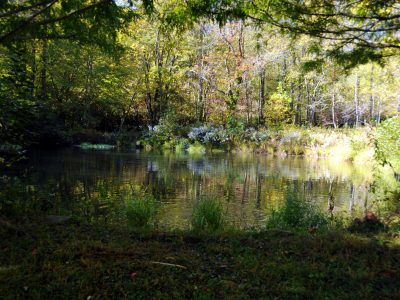
Forest Biodiversity
Forest Biodiversity
Simple models predict that biodiversity of forests should be much lower than that actually observed. Because only a few limiting resources are evident for trees, simple models would indicate that a forest would ultimately stabilize with only the few species that are the strongest competitors for the few available niches. However, observed diversity is much higher. High-dimensional regulation (for example, N limiting factors regulate N species) has long been recognized as a possible explanation, but the difficulty of identifying all the limiting factors and their interactions has proved prohibitory. To search for evidence of high dimensional biodiversity regulation, Coweeta researchers developed a hierarchical model allowing them to synthesize data from long-term experimental data sets with processes that control growth, maturation, fecundity, and survival. Their goal was to quantify interactions between demographic rates, within individuals, between individuals, and between species, as they respond to the environmental covariates of tree size and light availability
Data was taken from 26,000 trees across 268,000 tree years in forests spanning moisture and elevation gradients in the southern Appalachians, the Piedmont, and the transition between them. It was critical to examine so many trees because their hypothesis depends on individual level variation both between and within species, with the idea that individuals respond more like (and therefore compete more with) others of the same species, opening the door to greater coexistence between species. A long term approach was critical because such hypothesized high dimensional controls on diversity would vary within populations depending on the heterogeneity of conditions that different individuals experience in space and over time.
Their results are consistent with the hypothesis that species partition environmental variation, and that these tendencies to compete more with individuals of the same species can accumulate over time, providing a mechanism to promote and maintain diversity. Few long term data sets include observations of fecundity, growth, and survival from the same individuals, and none that the researchers are aware of analyze their interactions. The ability of the LTER to support such research over all three demographic schedules of individual trees was invaluable in building a successful model.
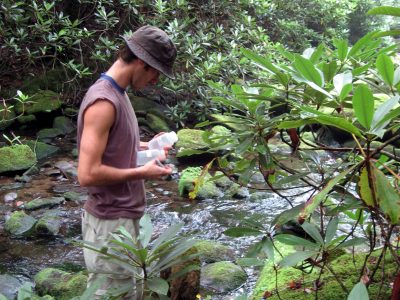
Future Nitrogen Cycling
Future Nitrogen Cycling
Understanding how global change will affect patterns of nitrogen (N) loss from forests is an area of special importance for researchers. Atmospheric deposition of N associated with anthropogenic activities and the sensitivity of microbial processes that convert organic N to plant available forms to temperature both point to the likelihood of increased N export from forests as increased rates of deposition and warming continue. Increased N export reduces water quality, long term forest productivity, and the ability of the forest to sequester carbon.
Microbes convert organic nitrogen (N) from decaying matter into plant available forms in a process of mineralization that is highly sensitive to temperature, increasing in rate as the temperature warms. This converted N is a critical determinant of plant growth and carbon sequestration, especially in N limited forests such as those that characterize the southern Appalachian region of the Coweeta LTER. However, though theoretical research and experiments at small temporal and spatial scales indicate high climate sensitivity of N mineralization, results have been difficult to scale to broader spatial scales, multiannual time periods, and more complex ecosystems. To address these gaps, Coweeta researchers modeled data representing 21-32 years of measurements of climate and water chemistry in two separate watersheds in order to disentangle the effects of atmospheric deposition and increased rates of N mineralization from temperature changes and to estimate the effects of climate change on N export. Separating the effects of global environmental change is a daunting task in terrestrial systems with extremely complex biogeochemical cycles, but one that can be facilitated by the combination of long term records and process-based evaluations.
The researchers were able to observe strong seasonal correlations between temperature and N export in streams, a pattern contrary to that observed in colder, more northerly forests that allowed them to separate the effects of N deposition from N mineralization. Results also indicated that a strong internal sink persists regardless of temperature, suggesting that seasonal increases in export during the summer months are driven by the supply of dissolved inorganic nitrogen made available through increased rates of microbial mineralization. Extrapolation of trends using the model indicate that future climate warming may increase N export by greater than threefold more than from increased deposition. The ability to anticipate the impact of future changes on water quality is of extreme importance in the southern Appalachian region, where the mountains are the effective “water towers” for the rapidly growing surrounding lowland regions.
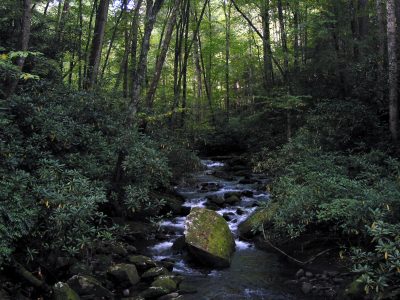
Climate Change and Habitat
Climate Change and Habitat
Ecologists have long been interested in how patterns of species distribution and diversity shift with changing climates, a concern that has spiked as the reality of rapid global climate change becomes increasingly apparent. Knowing whether certain species are threatened by shifting climate patterns is important for planning management activities and predicting how ecosystem functions can change in the future.
Coweeta researchers in the southern Appalachians, a global hotspot of biodiversity for lungless Plethodontidae salamanders, are especially concerned about the fate of these small but important creatures that play critical roles in terrestrial and stream processes. Because Plethodontidae salamanders are lungless and breathe through their moist skin, they are especially sensitive to shifts in temperature and precipitation. In order to predict how salamander populations will be affected by climate change, researchers modeled the population distribution under several different climatic future scenarios. They found, even using the most conservative assumptions about climatic shifts, that suitable habitat would likely contract by at least 20% by 2020.
These results are significant for a number of reasons. Firstly, it explicitly demonstrates that the salamander population of southern Appalachia is in danger of significant reduction and possible extinction of some species, and that this will likely have a significant impact on stream and terrestrial ecosystem processes. Secondly, this study predicts measurable declines in species diversity and abundance as early as 2020, in contrast to the majority of modeling efforts that focus on projections further into the future (2050 and beyond). These predictions present a unique opportunity for Coweeta researchers to use model outputs as testable hypotheses about species responses to climatic shifts. Though the models are strong in their ability to predict salamanders’ reactions to climatic shifts alone, in reality the ability of salamanders to disperse and follow suitable climatic habitat will also hinge on relationships with other species that might also be affected by climatic changes, and on geographical barriers to dispersal such as urban development or the presence of warmer, drier valleys for those that live at higher elevations. The long term climate and salamander abundance data at the Coweeta LTER, combined with the opportunity to test model outputs many years into the future, makes this an incredibly opportunity to study long term biotic shifts in response to climate change.
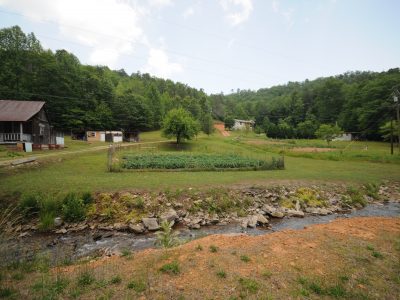
Clean Water and Land Markets
Clean Water and Land Markets
The growing population and increased consumption rates of the last hundred years make clear that we no longer have the luxury of using economic models that externalize environmental costs as if natural resources were infinite. The rapidly growing population in North Carolina- estimated to increase by 50% over the next quarter century and affect up to 8 million acres of natural land- is a prime natural laboratory to study the impacts of environmental regulation and ecosystem services on land values.
Urbanization impacts water quality and watershed health in three main ways: altering the hydrologic cycle through increasing areas of impervious surfaces; manipulating the physical environment; and contaminating the water chemistry through contaminants from a variety of activities associated with development such as landscaping, construction activity, and roads. The regulation of land use in a watershed can help reduce these threats by restricting land uses that individuals, enjoying the full benefit but paying only a fraction of the full social and environmental costs of such development, would be unlikely to observe on their own. The State of North Carolina Water Supply Watershed Protection Act was designed with just this purpose, and one of its most critical restrictions was a 2 acre minimum lot size that significantly impacted landowners’ ability to subdivide.
Coweeta researchers show through a study of vacant land markets around Asheville, North Carolina both before and after this critical legislation was passed that residential vacant lots supplied with surface water from a protected watershed were selling for higher prices than lots with other water sources. In the same study, we also show that people living in the protected watershed were being “taxed” in the form of declining property values, to provide the clean water that was making nearby properties more valuable.
While there exist many studies examining the effects of local land use regulations on property values, substantially less exist that address state and national land use initiatives that restrict density development or that are aimed at brining about environmental protection. This is the first research to empirically measure the effect of development density restrictions associated with water supply protection on land prices. Economists at the Coweeta LTER demonstrate that environmental factors like clean water have already been incorporated into the land market. This has happened as a result of regular market activities and not as a direct or intended consequence of actions taken by policy makers, showing that markets will be sensitive to changes in environmental quality, whether we actively account for that fact or not. However, if action were to be taken, a per capita tax of $276.24 would be sufficient to compensate those property owners whose property values were hurt by development restrictions.
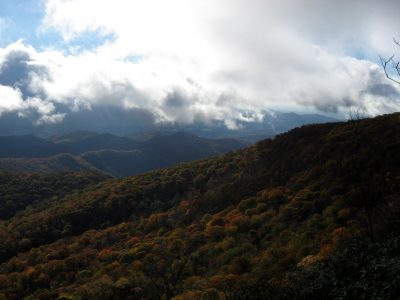
Predicting Regional Climate
Predicting Regional Climate
Predicting the impact of climatic changes on biota and ecological processes hinges on accurate projections of regional climate change. Researchers have already shown that there exists enormous variation in the manifestation of global climate change from region to region, with different areas of the globe experiencing widely varying shifts in climate patterns. Perched precariously in the middle of the rapidly growing Piedmont Megapolitan Region, the southern Appalachian region is characterized by high levels of endemic diversity and serves as a water tower for the widespread human development in the surrounding lowlands. Understanding how global climate change will manifest in this region and impact key ecosystem services of water quality, water quantity, and biodiversity will be critical to anticipating and preparing for impacts. Effective ecological impact research, though, is hampered by uncertainties surrounding regional manifestations of global changes.
Coweeta researchers examined eight decades of climate data available for the southern Appalachian region to assess the existence of any long term trends in climate and precipitation, to see if any such trends were linked to the North Atlantic Oscillation (NAO), and to see if changes in salamander abundance could be correlated with shifts in the NAO. The NAO is a recurrent teleconnection tied to relative atmospheric pressure differentials that influences weather in Europe and eastern North America. Though its impact on European ecology is well documented, its impact on North American ecology is relatively unknown.
By comparing annual climate measures across a series of weather stations in southern Appalachia, monthly NAO indices, and salamander abundance data, researchers showed a strong link between southern Appalachian temperatures and precipitation during the cool season and the NAO. Salamander abundance during the cool season was also found to be strongly correlated with the NAO. However, despite pronounced interannual variability in temperature and precipitation varying with the NAO, the researchers found no evidence of long term trends, suggesting that models that project rapid warming and drying by the end of the century may be inappropriate for use in southern Appalachia. Though the NAO seems to be a useful tool for predicting climate patterns in the region during the cool season, the lack of certainty regarding whether there will be reinforcement or weakening of this teleconnection means that researchers will have to consider multiple climate scenarios in order to capture the full range of possible ecological impacts in this region.

Controlling Plant Invaders
Controlling Plant Invaders
Invasive species are changing the structure and function of our native ecosystems, there is a need for effective management of these species to protect ecosystem services and biodiversity. Through a desk study which collated all published research on the primary plant invader of forests across 25 U.S. states, Microstegium vimineum, Coweeta researchers showed how ecological theory can be used to inform land management; most importantly, that metapopulation theory can be used to focus management on specific areas where the invader grows well, and that eradication of the invader from these areas should reduce its abundance across the entire landscape by removing the source of its seeds.
The fact that M. vimineum does well in moist riparian and understory habitats initially surprised researchers, as the grass employs the C4 photosynthetic pathway generally considered an adaptation for dry environments and commonly associated with invaders of open habitat. Coweeta researchers synthesized all available information on the species’ life history and habitat characteristics with the goal of understanding of how the unique invader’s niche requirements affect its population dynamics, and how an understanding of these population dynamics through space and time could produce better management recommendations.
Their approach was unique in two ways: it did not use landscape position as a proxy for niche requirements and it emphasized stage-specific investigation of niche limitations. Using landscape position as a proxy for niche requirements fails to elucidate subtle differences in habitat requirements, such as light or soil moisture, that vary over heterogeneous landscapes. Emphasizing stage-specific habitat requirements allows researchers to differentiate varying needs during germination, growth, and reproduction, helping to elucidate temporal variation in population dynamics. In the case of M. vimineum, researchers were able to discover that the grass was able to disperse and thrive along sunny and sometimes wet roadside habitats, which then acted as a source population for interior sink populations- those in the interior of the forest- that would otherwise not be able to sustain themselves from year to year. Though the habitat conditions under the canopy were sufficient to allow growth and survival for the year, they were not adequate for seed production and dispersal. Overall, this research demonstrates that identification of niche requirements, specifically as they vary over key demographic stages (recruitment, survival, growth, reproduction, and dispersal), can be useful to identify effective and efficient management strategies- in the case of M. vimenium of focusing eradication strategies on source populations.












